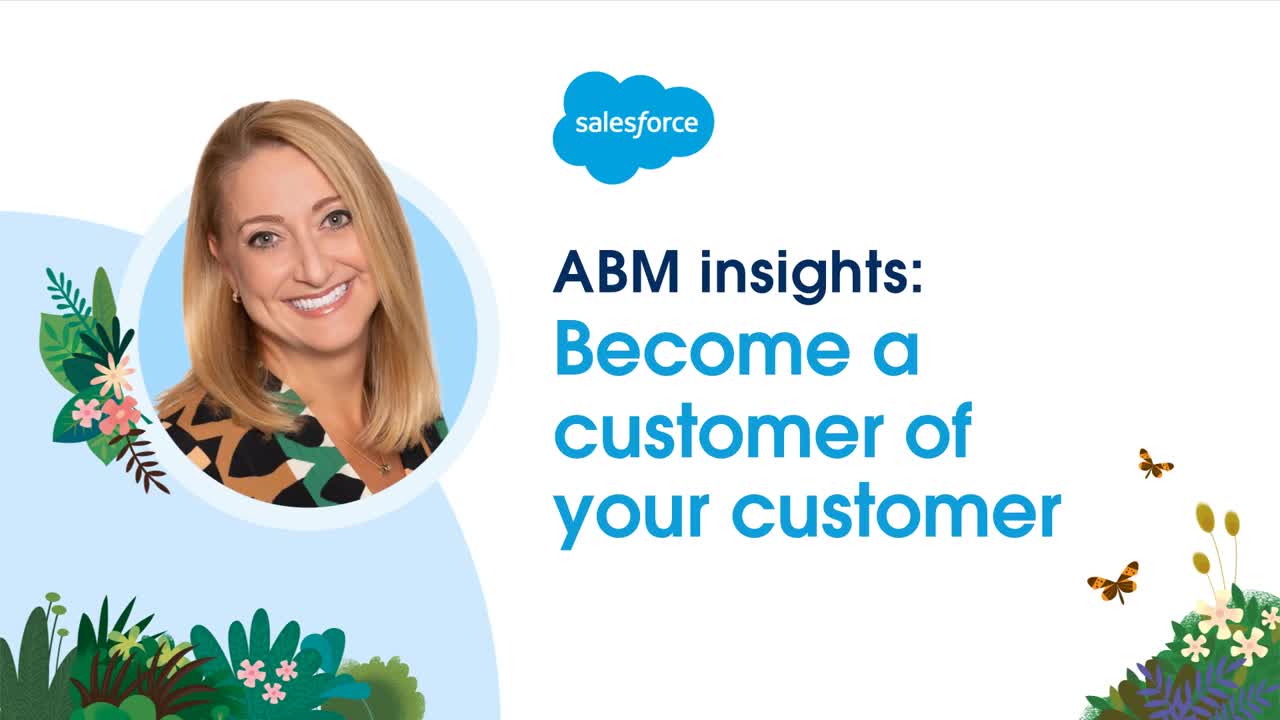Prior to joining Salesforce in 2017, I had launched and led account-based marketing (ABM) at tech giant IBM, and found not only a passion for being close to customers, but also discovered the value and impact of this style of marketing. In August 2019 I was asked to launch ABM here at Salesforce across Australia and New Zealand. In my role today, I draw from my 20+ years experience in product and services marketing, channel marketing, sales and consulting. I know the value of personalised marketing for business customers, and collaborating with sales and marketing colleagues is critical to drive customer value and joint success.
When we launched ABM at Salesforce in Australia and New Zealand, looking back it was not a moment too soon. Within a few months the pandemic caused in-person sales and marketing engagement to grind to a halt, yet businesses expected the relevant and personalised experiences that ABM is designed to deliver. At Salesforce, we recognised that this was the time for ABM to rise, and the 7th State of Marketing report highlighted the increased popularity of this sophisticated B2B marketing.
For those new to account-based marketing, it starts with the needs of an account and is a strategic approach that combines targeted, personalised and insight-led marketing with sales to increase mindshare, strengthen relationships, and drive growth in specific new and existing accounts, delivering a high return on marketing investment.
There are two reasons that ABM is taking centre stage to reach valued business customers right now.
Firstly, ABM is more successful when positioned as a strategic corporate growth program, not just as a marketing program or tactic. By centralising and embedding ABM in your organisation, you can deliver an informed and more consistent and personalised experience much faster. This drives impact across the customer lifecycle, across various touchpoints, delivered by several members and functions within your organisation.
Secondly, prior to the pandemic, the most successful ABM programs were in-person engagements. The past 12 months have seen ABM programs innovate with digital programs, direct mail, online discussions, digital events and even podcasts. So having the best technology to provide you real-time insights and allow you to personalise at scale and in real time has become even more critical. To combat digital fatigue, we needed to innovate to excite and inspire our audiences in new ways, which is where our detailed insights helped to create relevant, personalised content for cut through.
Trends to watch in account-based marketing
As ABM programs and the profession are still maturing, some top trends are emerging. Across all campaigns, the key is to offer a personalised and relevant experience at every opportunity. In the B2B landscape this draws on every data point you have as a marketing professional, informed through close collaboration with your sales and service teams, in-depth contact with your customers, data in your CRM and external data such as intent.
These are the top trends to watch.
1. Account selection can make or break your ABM Program
Account selection is the single most important step in the ABM process and done well, will help you lay a strong foundation for your ABM program. After all, the difference between account-based marketing and targeted account marketing is that ABM starts with the needs of an account.
Who are you going to serve and what problems can you solve for them?
Get account selection wrong and there is no engagement strategy, content or tactic that will right the wrong, often leading to a poor experience for the target customer, your sales team and you. On the other hand, the right accounts matched with personalised messaging and touchpoints will lead to better engagement, faster deal velocity and larger deals. It is a win-win scenario.
Data points to consider in your account selection come from a variety of sources, internal and external, industry and market insights. Does this account fit the profile of your ideal customer? Do you have referenceable customers from their industry? Is their industry growing in their appetite for your solution? And importantly is your sales team for that customer open to engaging with a new style of marketing?
ABM doesn’t happen without the sales team, so invest the time with them early and often, and set realistic expectations.
2. Become a customer of your customer
Naturally, ABM starts with the needs of the customer. We listen for insights which can emerge internally or externally. No doubt many of you are already subscribing to the intent data of your customers and gathering insights from your own CRM, combined with talking to your sales teams frequently.
One of my favourite approaches is to become a customer of your customer. This helps you identify pain points and opportunities from the customer’s perspective that they may not be aware that your solution could solve, and they’ll also be impressed you went to the effort. Using that insight from being their customer means you can also develop creative marketing programs, content and messaging that speaks to these in detail.
3. Personalisation at scale
As a consumer, we enjoy personalised experiences from brands every day. In our business life, we can now start to also expect that level of tailored experience. In my view I see that B2B marketers can embrace personalised marketing at every opportunity. Business marketing can now be called “Business to Person” as we are aiming to reach the individual behind the brand, the buyers, decision makers and influencers. This relies on highly sophisticated marketing to create a bespoke experience for the individual.
If you haven’t already, I also suggest you invest in technology that will provide real-time analytics and insight tools, and ensure it connects to the marketing, sales and service efforts across your organisation. We also need to think about automation and scale in a much more personal way and trigger personalised communications based on what our insights and intent actions are showing us.
ABM can be resource intensive so it’s important to start small, capture learnings quickly and realise it’s okay to scale either up or down.
Some examples of personalisation have emerged in the technology sector to address long sales cycles and complex customer relationships and larger deal sizes. Brands like Splunk and Autodesk have really embraced the COVID-friendly ABM toolkit by using deep account insights delivering hyper-personalised digital assets and hubs.
My Salesforce colleagues in the US, UK and Europe have also been winning ABM Industry awards in the last 6 months for their one-to-one and one-to-few programs. In the UK, the online Dreamforce experience elevated the personal touch to a new level. To create that bespoke experience, the team designed exclusive executive programs, dedicated microsites, customised newsletters and even a tailored online learning platform.
Closer to home, it’s been great to see APAC take a more leading role in ABM strategy-setting and program delivery. We’ve been trialling new technology to help our sales teams amplify relevant real-time messages over social media via an app. It provides articles that match their customer’s interest based on real-time intent data so they can amplify relevant content on social media in just a few clicks.
4. Facilitating Peer-to-Peer learning and networking
Our customers tell us that they often learn the most from listening to other customers, their journeys, insights, opportunities and challenges. At Salesforce, we’re always looking for ways to create valuable learning experiences for our customers. At the same time, we like to showcase our customers’ success at every opportunity. Earlier this year we launched the first-ever six-part podcast series featuring APAC customers called The Future of Business, Now. With the onset of digital fatigue, this was an experiment for us that gave our customers the chance to share their experience, insights, success and learnings, and for other customers to learn from their peers, through short and sharp episodes that didn’t require them to be looking at a screen.
We followed our podcasts with virtual “Customer Council” roundtable discussions around topical themes, where our customers could learn from one another in a live online discussion – not a one-way webinar. Connecting our customers (known as Trailblazers) with one another is a role we are proud to facilitate. The comments from our customers at these events speaks to the value of learning from peers across industries.
“What a great way to bring multiple industry verticals together to share knowledge and business outcomes. Brilliant to meet everyone, thanks for the opportunity. Very helpful insights from both organisations’ transformation journeys.”
“This was exciting and refreshing. Always great to hear what other businesses are achieving and what’s possible.”
“Huge thanks to Salesforce. Great to connect and be able to step away from the ‘day to day’ to think creatively and be challenged.“
5. Creating experiences that showcase your common values
As part of our reputational and relationship ABM programs, I also like to ensure that we authentically connect with our customers around any joint values we may share. At Salesforce, we’re serious about driving customer success and creating positive change in the world. One of my favourite examples of values-based experiences is to do good in the community, alongside your customers. Like many of our customers, Salesforce is on a mission to drive meaningful climate action at scale. So as part of our Dreamforce event, we planted over 1000 trees with one of our like-minded customers. In another local campaign, we worked with IAG to bring our people together for the Long Walk Home with Wayside Chapel to help raise funds and awareness for homelessness. You can watch the highlights video here.
6. Smart measures help leading brands excel
Account-based marketing programs have a longer time horizon than other forms of marketing. So strategic, long-term metrics are essential for sustained business impact. Aim to carve out time, budget and effort for reputational and relationship programs to build trust, especially if you have a long sales cycle and a product or service considered strategic and critical to their business operations and individual careers.
At Salesforce we follow the ITSMA framework for measuring ABM on the 3R’s: reputation, relationships and revenue. This is not simple, and differs to how marketing may be traditionally measured which is why our Salesforce ABM Centre Of Excellence has helped to standardise our ABM measurements and dashboards all over the world. In a matter of a few clicks, you can view a dashboard, using Tableau CRM and Einstein analytics to show the ABM results by program, campaign, country, account and specifics against the 3R’s.
Think big, start small and move fast
When I think of the power of account-based marketing, and for those of you looking to get started, I like to say, think big, start small and move fast. Be bold enough to select a few ideal ABM customers, partner with an awesome sales team on those accounts, and experiment with personalised and relevant programs informed by detailed insights. Then use your momentum and success to expand the program appropriately, and never lose sight of the personalisation.

























